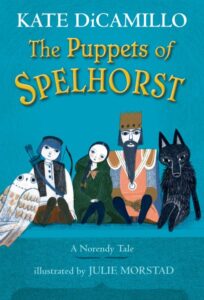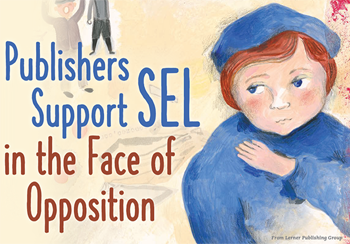Review of the Day: The Puppets of Spelhorst by Kate DiCamillo, ill. Julie Morstad

The Puppets of Spelhorst
By Kate DiCamillo
Candlewick Press
$17.99
ISBN: 9781536216752
Ages 6-10
On shelves October 10, 2023
I’m no story theorist. I can quote the rudimentary ideas that the pros like to bandy about, but I’ve never made a serious study of their rules and regulations (The Secrets of Story being the sole exception, naturally). Still, there are a couple ideas I’ve picked up over the years that make sense to me. For example, let’s consider the idea of the “passive protagonist”. This would be a character that can’t or won’t do anything to change their circumstances. It’s supposed to be a bad thing. The ultimate withering insult to a writer. “Oh. Your main character? They’re a little . . . passive, wouldn’t you say?” The horror. And yet, consider how many children’s books feature toys or puppets that cannot move. Sure, the bulk of stories tend to go the Pinocchio/ Mouse and His Child route and allow their characters a bit of impetus and movement, and why not? Quite frankly that’s the easier story to write. But Kate DiCamillo has never been a particular fan of doing things the easy way. That’s why her latest story The Puppets of Spelhorst is so utterly fascinating. After reading it, I’ve had to rethink my entire “passive protagonist” theory as it relates to stories of children’s toys. But much more importantly, this is the kind of book that’s going to appeal to kids young and old. A contemporary classic with ingrained appeal and the occasional jolt of weirdness to keep things interesting.
Five puppets hang in the window of a toy shop: An owl, a boy, a girl, a king, and wolf. One day, an old sailor named Spelhorst buys them, if only because he’s entranced by the girl puppet’s eyes. When he dies, the puppets are taken from place to place, only to ultimately end up in the possession of two young girls. While each puppet has his or her own dreams about what they’d like to accomplish in life, they know they must stick together. Only through great trials, separation, reunification, and the power of storytelling itself, do they come to realize their true purpose.
ADVERTISEMENT
ADVERTISEMENT
I like watching Kate DiCamillo grow and change as a writer. I don’t know why, but no other author seems to exhibit such an interesting trajectory. She comes out of the gate with Because of Winn-Dixie (strong start), wins herself some awards, and then shifts a little. She writes younger (Mercy Watson) and older but ultimately writes what she wants to, not what she has to. Her choices are not obvious. She might co-write a book about best friends one moment and then do a three book series of three friends in Florida the next. Then a superpowered squirrel. Then a malicious goat. With The Puppets of Spelhorst she’s written a shorter story. Just a scant 160 pages, and with all the trappings of a bedtime tale. The focus starts with an old man, fixates on the puppets, occasionally breaks free to get the thoughts and opinions of other humans, but ultimately stays with the toys in the end. This may sound hectic, but DiCamillo’s a sure hand. You are never confused about who is speaking at any given moment. All told, in spite of a harrowing separation halfway through the book, I found this a comforting story. Friends are separated, but they come together again. A story is told, and everyone gets a part.
All that I’ve written here is true, but none of it explains how DiCamillo makes this book work. You see, this isn’t the first time she’s had a passive protagonist before. Years and years ago she wrote a book called The Miraculous Journey of Edward Tulane about a china rabbit toy. And at the time of its, I was not a particular fan. There was something about that strong undercurrent of cruelty that ran through both it and her Newbery winning Despereaux that felt wrong. But on top of that, there was the fact that while horrible thing after horrible thing happens to Edward (and no one’s life is much better after having met him) he can do nothing to change his circumstances. His attitude, sure. But his circumstances? Not at all. Interestingly, this deep and abiding frustration I’d felt with that book never came up at all with Puppets. Why is that? I’ve pondered this for a long time, and at last I came to the conclusion that I was wrong about my criticism of Tulane all those years ago. My reaction to it was never, honestly, based on the fact that he was a “passive protagonist”. Not really. If that had been my issue then I would have had the same problem with Puppets. No, like this book, Tulane showed how a protagonist’s interior life can be as interesting as their physical one. The difference, I think, is in how each book depicts the cruelty of the world. In Tulane actions happen without meaning. A fry cook might destroy your main character’s head for literally no reason at all. But in Puppets, when cruelty happens it’s never malicious. If it happens it happens because characters are wrapped up in their own lives and cannot consider the effects their actions might have on others. So when I read this book, I can see myself in both the heroes and the villains. In Tulane I never had that chance.
Another reason I enjoyed this book particularly came when I realized that in Tulane the main character is utterly alone in the world. In Puppets the main characters rely upon one another. Each has his or her own adventure (except for the King, but you really aren’t all that upset on his account). They don’t always appreciate what anyone else has to say at first, but as the book continues you realize that they rely upon one another. Plus, their thoughts are given the chance to sometimes be internal and sometimes shared with others. Was this the reason why I enjoyed this book as much as I did?
Maybe. But not entirely.
Turns out, the true reason came only at the book’s very end.
You see, I’d walked into this book truly believing (probably because of the title) that the heroes of this book were, in fact, the titular puppets of Spelhorst. But they’re not, are they? Not really. They’re great characters and you care for them. Therefore, they are most certainly the protagonists of the text. But are they the heroes? I liked very much the interior journey each character took (even the king, to some extent) and that made them folks I rooted for. However, the true hero of this tale is only revealed at the story’s end and, like the puppets, once you realize who it is, you too would follow that person to the ends of the earth. Once I shifted my thinking and realized this, the entire book’s success fell into place. For the puppets, each one of them has dreams and hopes, however, fabulous or outlandish. And through fabulous and occasionally outlandish means, they fulfill their destinies. But the hero of this tale can’t fulfill their dreams within the confines of this particular story. And so the tale ends with them setting off to see the world, the way they wanted to. It’s so oddly satisfying. I hope kids see it the same way.
Now I would like to request, quite swiftly, that someone go on and set the three songs we see in this book to music, stat. Nothing ever happens quickly in the art world, but things are capable of happening very quickly on social media. So if one of those nice musically-inclined young people who grew up with DiCamillo’s books when they were little could heed my call and please make tunes to accompany her words, I’d be much obliged.
I do feel a bit bad that I haven’t mentioned artist Julie Morstad until this moment. I first encountered Morstad’s art years ago when I found her illustrating a Robert Louis Stevenson poem called The Swing in board book form. Instantly I was charmed, and I’ve faithfully followed the trajectory of her career in children’s literature ever since. Her pairing with DiCamillo reminds me of when DiCamillo was paired with Sophie Blackall for The Beatryce Prophecy. Critics like myself were left just thinking, “Well, duh. Haven’t they worked together before?” They have not. Certainly DiCamillo has never done anything at all with Morstad in the past, but linking the two together is mild genius. Morstad’s art is subdued but not emotionless. Her puppets in this book look out onto the world blankly, but you can sense, just looking at them, their interior lives. When humans make their appearance on the page (as humans are, sadly, wont to do) there’s an almost Edward Gorey-esque quality to their detachment. You feel for them… but honestly you feel for the puppets more. (Additional Note: If we do not see a Kate DiCamillo/Jon Klassed at some point in the next five years I shall think it a very great mistake on the part of the publishers. I mean, the obvious pattern here is Blackall to Morstad to Klassen. Debate me if you will).
There’s so much more to talk about with this book. The role of the girls who play with the puppets and how their very different impressions of them cause great changes. The role of the maid Jane Twiddum and what she wants. Heck, there’s a whole undercurrent of feminism and the roles puppets and living women play within society, but I suppose I’ll save that for someone else’s thesis. The important thing to understand is that this is a story where it doesn’t matter how physically passive you are. Your interior life, your hopes and dreams and goals, that’s the thing that matters. That’s what’s going to make you into an active protagonist in the end, regardless of whether or not you have the ability to move. The Puppets of Spelhorst taught me that. Now imagine what it could teach your own children.
On shelves October 10th.
Source: Galley sent from publisher for review.
Filed under: Best Books, Best Books of 2023, Reviews, Reviews 2023
About Betsy Bird
Betsy Bird is currently the Collection Development Manager of the Evanston Public Library system and a former Materials Specialist for New York Public Library. She has served on Newbery, written for Horn Book, and has done other lovely little things that she'd love to tell you about but that she's sure you'd find more interesting to hear of in person. Her opinions are her own and do not reflect those of EPL, SLJ, or any of the other acronyms you might be able to name. Follow her on Twitter: @fuseeight.
ADVERTISEMENT
ADVERTISEMENT
SLJ Blog Network
Name That LEGO Book Cover! (#53)
Exclusive: Vol. 2 of The Weirn Books Is Coming in October | News
Fighting Public School Book Bans with the Civil Rights Act
North Texas Teen Book Festival 2024 Recap
ADVERTISEMENT








After reading your comments this morning about The Puppets of Spelhorst and then again this afternoon, I found myself running to Amazon to see what others have to say about this book. No customer reviews yet but several positive comments and starred reviews from several of my favorite and respected resources. Because of Winn-Dixie is just one Kate DiCamillo book I love and I have admired her talent and range of subject matter over many years. I choose books selfishly concerned only with how I might personally respond to a story. Regardless of my reaction I feel confident donating to the library anything approved by the “experts” believing there will be children who will enjoy the book.
What I found amazing today was the space you devoted to your own thoughts about how your personal reactions to earlier DiCamillo books have evolved over time. What a good example of how time and experience can change our perceptions. I enjoyed reading what you had to say.